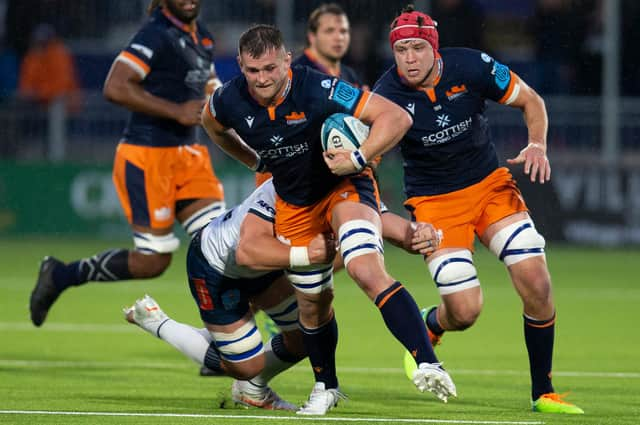Allan Massie: I once put Magnus Bradbury in Peter O'Mahoney bracket - and it's still not too late


That way, long before there could be any video coverage of the play, he could more easily identify which players were doing the right thing in scrum or ruck and, more importantly from my memory of him, which were clumsily putting ta foot in the wrong place and therefore merited stern reproof.
I don’t suppose there were any such thoughts in Mike Blair’s mind when his Edinburgh side took the field against Benetton all wearing – the press release told me – “the socks of their boyhood club”. Not at all: the intention was to show their appreciation of the importance of the club game. This was a nice idea certainly, though, given that half-a-dozen of the starting XV had no Scottish boyhood club, some of the club socks may have been having their first outing.
Advertisement
Hide AdAdvertisement
Hide AdHowever, one player stood out, and did so for two reasons. This was Magnus Bradbury, whose club of origin was Oban Lorne. Given how little space in the national press there is now for the amateur game, it is easy to forget how remarkably it has spread in my lifetime. Oban Lorne RFC was founded in 1962, and so will celebrate its 50th birthday next year. A great many other clubs are younger, some much younger. When I was a boy there were, I think, no rugby clubs in Aberdeenshire except the five in the city: Aberdeen Grammar FPs, Gordonians, Aberdeenshire, Aberdeen Wanderers and Aberdeen University. Now there are at least half-a-dozen in the county and this pattern is repeated all over Scotland with clubs even in Orkney and Shetland. You have to be really committed to make long journeys to play matches.
Naturally most of our attention is focused on Scotland, Edinburgh and Glasgow, but the health of the game depends first and foremost on the amateur clubs and on the non-playing – in many cases past-playing – members who devote so much time, energy and enthusiasm to keep them going. Few of them ask for any reward or recognition, though it is pleasing when this happens, and indeed Magnus Bradbury’s mother, representing Oban Lorne, has recently served with distinction as the SRU President.
This Friday’s match was Magnus’ 100th game for Edinburgh, a figure reached only by 35 other players. He is the fourth back-row forward to reach the 100 mark, the others being Simon Taylor, Ally Hogg and Roddy Grant. He has also won 14 Scotland caps. This is of course a respectable figure, and he is still only 26.
Nevertheless, it is fair to say that he has never quite become the consistently formidable player he promised to be, having also – perhaps unfairly – been accused of tending to drift in an out of games. This is of course a charge often made against other players who sometimes win more admiration and respect from spectators than from coaches who have all matter of video evidence on which they base their judgement.
Be that as it may, five or so years ago, watching and being impressed by the young Bradbury, I confidently judged that he was going to be as important to Edinburgh and Scotland as Peter O’Mahony has been to Munster and Ireland, and there have been very few flankers of recent years I rate as highly as I do O’Mahony. The young Bradbury seemed to have something of O’Mahony’s devil in him.
It hasn’t quite worked out like that, but it certainly isn’t too late. Some players mature early as, for instance that previous Edinburgh centurion Allie Hogg did; others reach their best later.
There is no better example of this in Scottish rugby history than Finlay Calder, who became unquestionably one of our greatest-ever flankers. Yet, for a long time, he was a not-quite-there man, grand club player, not quite – in selectors’ judgement -international class – unlike his twin brother Jim who was capped first in 1981 and scored famous tries against Wales in Cardiff and France in the Grand Slam decider in1984. Fin never played in the same Scotland side as his twin, his international career running from 1986 to 1991. He too had a Grand Slam win to his name (England 1990, in case you forget) and captained the Lions in Australia in 1989. My memory, which may be faulty, is that in his middle 20s he was told by Jim Telfer, in, one would imagine, no uncertain terms, that he wasn’t making the most of his ability and should … well, you can guess the rest of the story as retailed to me.
Magnus Bradbury is still younger than Fin was when he was first picked for Scotland and embarked on the most glorious years of his rugby career. Perhaps Gregor Townsend or Mike Blair might ask Jim Telfer to have a few words with young Magnus.